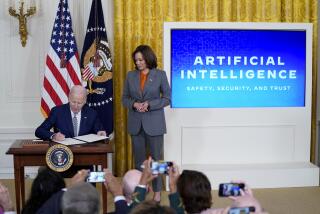Top Soviet Minds Try to Reinvent Lives in America
- Share via
In the old Soviet Union they were eminent members of the intelligentsia, highly trained scientists and doctors and engineers who staffed prestigious research institutes and powered a once-proud high-tech industry.
In Los Angeles, though, they’re part of the struggling immigrant masses, scraping along in West Hollywood with help from family and Social Security, their prospects less than promising. Many a skilled American has struggled to find a place in the new economy when big companies downsized; imagine trying to find a job at 55 or 60 when you can’t even speak English.
But in admirable entrepreneurial fashion, this group of emigres is determined to find a way. Led by a hardheaded patent lawyer from Moscow named Ilia Orkis, they’ve formed the American Assn. of Inventors From the Former USSR and Eastern Europe, with the hope that somehow they can make their collective cleverness useful in their new country.
It won’t be an easy road, of course. But the fate of the effort will speak not only of the resourcefulness of the individuals involved but also of the strengths and weaknesses of our own laws and institutions--including that of a patent system that’s now on the verge of major change. In its single-minded drive for military strength and superpower status, the old Soviet Union made enormous investments in scientific and technical training, and America’s vibrant high-tech economy ought to be able to profit from it.
In numerous ways it already has. Ambitious companies such as Sun Microsystems have been prospecting in the old East Bloc for years now, buying stakes in promising companies, developing contract research arrangements, and recruiting the best and the brightest to come to the U.S.
A few Russian entrepreneurs have also established successful high-tech companies in the U.S. and in Israel.
One of them, a 3-D graphics software company called Paragraph International that counts chess champion Garry Kasparov among its backers, has just been acquired by Silicon Graphics.
In important respects, though, these efforts are only skimming the surface. For every young, English-speaking, Western-looking Russian programmer who might find work with a Sun or an Intel, there are probably several better qualified but older and less flexible scientists and engineers who don’t know quite where to turn.
People like Yefim Shtengold, who oversaw the first artificial heart program in the Soviet Union and has more than 300 published papers and 70 Russian patents, but isn’t yet ready to retire; or Sergey Chernyavskiy, a physicist who ran a major ballistics laboratory in Moscow and was admitted to the U.S. as a foreigner of exceptional ability, only to find that he cannot get work in his field until he acquires citizenship; or Victor Krasnov, an accomplished semiconductor engineer who finds himself massively overqualified for the types of jobs available to a 49-year-old with limited English and little familiarity with U.S. business practices.
They’re all in Los Angeles now, hoping that the new inventors association might help them get a break.
These emigres each had their own reasons for leaving the old country. Shimon Shchegel, a chemical technology researcher, fled Baku, Azerbaijan, in 1991 after his son was killed in the brutal war there. Yakov Istkovich, a soft-spoken wood-processing expert and onetime Greco-Roman wrestling champion, was forced to leave Tashkent, Uzbekistan, as a result of ethnic conflict. Leonid Kochergin, a physicist and member of the prestigious Russian Academy of Sciences, was too much the free thinker for his Communist Party bosses--and, like many of the emigres, suffered discrimination and threats because he is Jewish.
*
Like the immigrants who came before them, these men are finding that the streets of America are not quite paved with gold. Some are old enough to qualify for modest Social Security payments, and others work at menial jobs and count on the kindness of friends and relatives.
Some have mostly given up on continuing their careers here and aim mainly to create a better life for their children.
But maybe, they hope, this new association will lead to something. Together, the 70-odd members of the group have a portfolio of more than 500 inventions in a wide range of fields.
Individually they don’t have the means to patent or market their innovations, but collectively they might have a chance.
Of all the ways to get ahead in America, though, freelance inventing is one of the hardest--even for the smoothest-talking native. Independent inventors are often in the position of pitching their ideas to companies that are dismissive at first, then all-too-eager to claim an idea as their own if it proves worthwhile.
Selling an idea while simultaneously protecting it is never an easy thing. As Rusty Ruscetta, chief operating officer of a Glendale-based organization called the Inventors Assistance League, points out, there are all manner of scam operators out there who say they’ll promote your invention for a price--and then simply take the money. Ruscetta’s group has agreed to work with the emigres.
Then there is the patent question. Filing for a patent can cost many thousands of dollars, and in most cases--more than 90%, according to Ruscetta--the invention will never earn a dime.
Impecunious entrepreneurs such as the Soviet emigres can, however, take advantage of the fact that America’s unique patent laws grant rights to the person who came up with the invention first, not to the person who files for a patent first.
Thus a person or group can keep careful records and file for a patent only after they know it has commercial potential.
A proposed overhaul of the U.S. patent system--designed to bring it into line with international norms and strongly supported by the technology industry--had at one point threatened to change that, giving the rights to the first person to file. The Patent Office ultimately chose to retain “first to invent.”
But there’s still a bitter fight over proposals to require publication of patent applications after 18 months--often long before the patent has been issued--and to make it easier to challenge patents.
*
The changes are vehemently opposed by independent inventors, and while a bill passed by the House last month mostly removed both of those provisions, they remain in a Senate bill that is expected to come to a vote soon. Inventors also are still battling a provision granting so-called prior-user rights to anyone who might already have been using a technology that’s later patented. The current system, they say, has worked, and it gives even the most powerless little guys--immigrants included--a chance.
I must confess that I once dismissed the concerns of the independent inventors in print as selfish whining, but I now think they are right. Changes that disadvantage lone wolfs and small firms in favor of lawyer-heavy corporations aren’t good for innovation in the long run.
And that brings us back to Orkis and his compatriots. The U.S. has already shown its wiser side by enabling them to immigrate in the first place; an effort to limit the influx of technically talented foreigners on the grounds that they steal jobs from Americans was, fortunately, rebuffed last year.
Lawmakers should resist changes in the patent system--including the 18-month publication and the easier challenges--that make it more difficult for creative but resource-poor people to bring good ideas to market. (Orkis even has an improvement in mind: The Patent Office should have a procedure for waiving fees in exchange for a government stake in the invention. A rather statist idea, certainly, but not a bad one.)
Corporate America, for its part, should continue to look for new ways to tap the talents of people who don’t fit into traditional channels.
“I don’t think we are doing as much as we could,” says Arvind Deogirikar, business development manager at Sun who spent several years in Russia.
Indeed, being flexible and versatile enough to use talent and ideas in whatever form they present themselves could almost be a definition of a well-run company, or a well-run country. The experience of immigrants--as always in this country--helps show us how we’re doing.
*
Weber is editor of The Cutting Edge. He can be reached via e-mail at [email protected]. The American Assn. of Inventors From the Former USSR and Eastern Europe can be reached at (213) 937-0509.






